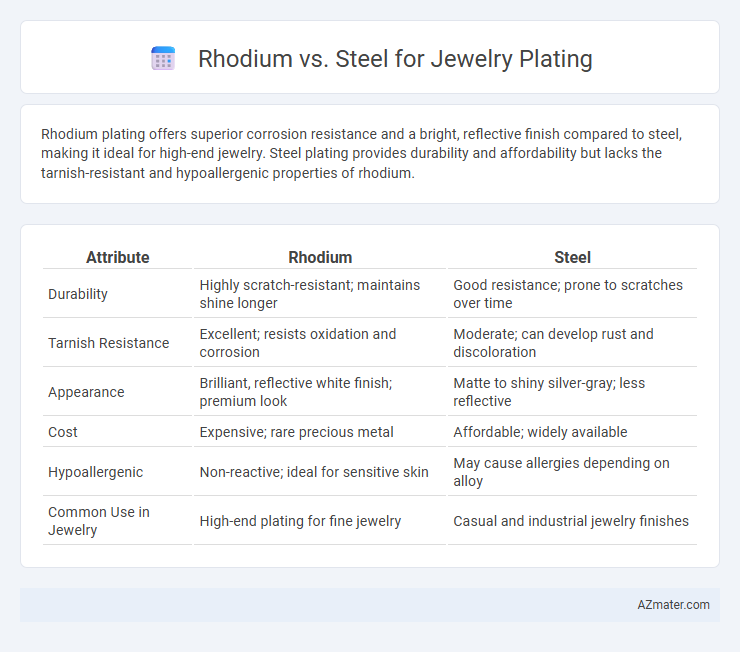Rhodium plating offers superior corrosion resistance and a bright, reflective finish compared to steel, making it ideal for high-end jewelry. Steel plating provides durability and affordability but lacks the tarnish-resistant and hypoallergenic properties of rhodium.
Table of Comparison
| Attribute | Rhodium | Steel |
|---|---|---|
| Durability | Highly scratch-resistant; maintains shine longer | Good resistance; prone to scratches over time |
| Tarnish Resistance | Excellent; resists oxidation and corrosion | Moderate; can develop rust and discoloration |
| Appearance | Brilliant, reflective white finish; premium look | Matte to shiny silver-gray; less reflective |
| Cost | Expensive; rare precious metal | Affordable; widely available |
| Hypoallergenic | Non-reactive; ideal for sensitive skin | May cause allergies depending on alloy |
| Common Use in Jewelry | High-end plating for fine jewelry | Casual and industrial jewelry finishes |
Introduction to Rhodium and Steel in Jewelry Plating
Rhodium plating in jewelry enhances durability and provides a brilliant, reflective white finish that resists tarnishing and corrosion, making it ideal for high-end pieces. Steel plating, often stainless steel, offers excellent strength and scratch resistance with a naturally lustrous silver-gray appearance, suitable for everyday wear and budget-friendly options. While rhodium plating is prized for its luxurious shine and hypoallergenic properties, steel plating excels in robustness and affordability for jewelry applications.
Composition and Properties of Rhodium
Rhodium is a rare, silver-white metal belonging to the platinum group, characterized by its exceptional hardness, high reflectivity, and excellent corrosion resistance, making it ideal for jewelry plating. Its composition as a noble metal ensures non-reactivity and hypoallergenic qualities, outperforming traditional steel plating which may be prone to rust and tarnish. Rhodium's dense atomic structure provides superior scratch resistance and maintains a bright, durable finish, enhancing the longevity and aesthetic appeal of plated jewelry.
Composition and Properties of Steel
Steel used in jewelry plating primarily consists of iron with carbon content typically below 2%, enhancing its hardness and durability. Its corrosion resistance varies depending on the alloying elements, such as chromium and nickel, which form stainless steel grades used for hypoallergenic properties and tarnish resistance. Unlike rhodium, which is a rare, hard, and highly reflective precious metal, steel provides structural strength but requires plating for enhanced surface luster and protection against oxidation.
Aesthetic Appeal: Rhodium vs Steel Plating
Rhodium plating offers a brilliant, reflective finish with a bright white luster that enhances the sparkle of jewelry, making it highly prized for its luxurious and elegant look. Steel plating, while durable and resistant to tarnish, typically presents a more understated, matte or brushed metallic appearance that suits modern, industrial styles. The choice between rhodium and steel plating for jewelry primarily depends on whether a high-gloss, radiant finish or a sleek, minimalist aesthetic is desired.
Durability and Wear Resistance Comparison
Rhodium plating offers superior durability and wear resistance compared to steel, making it a preferred choice for fine jewelry due to its brilliant, tarnish-resistant surface that maintains luster over time. Steel, while robust and resistant to scratches, tends to corrode and lose aesthetic appeal faster under daily wear conditions. The hardness of rhodium, combined with its chemical inertness, ensures prolonged protection against oxidation and scratches, outperforming standard steel plating in long-term jewelry applications.
Cost Analysis: Rhodium vs Steel for Jewelry
Rhodium plating offers a high-end, reflective finish commonly used to enhance the appearance of precious metals but comes at a significantly higher cost compared to steel plating, which is more budget-friendly and durable. The price per gram of rhodium frequently exceeds that of steel by several thousand percent due to its rarity and intensive refining process, impacting jewelry production costs. Steel plating, while less reflective, provides an economical alternative with superior resistance to corrosion and wear, making it favorable for cost-conscious consumers.
Hypoallergenic Qualities: Which is Safer?
Rhodium plating is renowned for its superior hypoallergenic properties, making it a safer choice for jewelry plating compared to steel, which can contain nickel and cause allergic reactions. Rhodium's inert nature prevents skin irritation and is commonly used to coat white gold and silver to enhance durability and reduce tarnishing. Steel plating, especially stainless steel, offers durability but may trigger allergies in sensitive individuals due to trace amounts of nickel or other alloys.
Maintenance and Care for Rhodium-Plated vs Steel Jewelry
Rhodium-plated jewelry requires delicate maintenance to preserve its reflective finish, as frequent polishing and avoidance of abrasive cleaners prevent surface wear and tarnishing. Steel jewelry offers higher durability with minimal upkeep, resisting scratches and corrosion without special treatments, making it ideal for everyday use. Proper care for rhodium plating involves re-plating every 1-2 years to maintain its protective layer, whereas stainless steel retains its look longer with simple cleaning using mild soap and water.
Environmental Impact of Rhodium and Steel Plating
Rhodium plating offers superior corrosion resistance but involves energy-intensive mining and refining processes that contribute to significant environmental degradation and hazardous waste generation. Steel plating, particularly with stainless steel, often employs less toxic methods and benefits from recyclable material properties, reducing overall ecological footprint. Choosing steel plating can support more sustainable jewelry production by minimizing resource extraction and promoting circular economy principles.
Choosing the Best Plating Material for Your Jewelry
Rhodium plating provides a brilliant, reflective finish resistant to tarnishing and scratches, making it ideal for high-end jewelry requiring long-lasting shine. Steel plating offers durability and corrosion resistance at a lower cost but may lack the premium luster and hypoallergenic properties of rhodium. When choosing the best plating material, prioritize factors such as desired aesthetic, skin sensitivity, and budget to ensure your jewelry maintains its appearance and comfort over time.

Infographic: Rhodium vs Steel for Jewelry Plating
 azmater.com
azmater.com